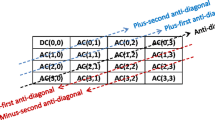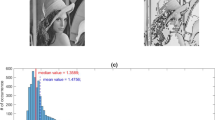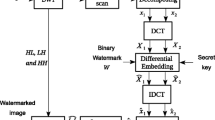Abstract
The distinctive properties of partly sign-altered (PSA) coefficients in discrete cosine transform (DCT) domain are explored to achieve effective dual blind image watermarking. A host image is divided into non-overlapped blocks, each of which is then converted to a DCT representation separately. For each block, low-frequency DCT coefficients are selected for dual binary watermarking. The first binary bit is applied to the mean value of the PSA coefficients. Our formulation takes into account of human psychovisual characteristics. A stair-like quantization function is designed to not only regulate embedding strength but accommodate extra embedding for blocks with high contrast masking. In case second watermarking is requested, we tactically adjust the standard deviation of the PSA coefficients while keeping the PSA mean intact. The embedding strengths with respect to the involved parameters in the first and second watermarking are analytically examined. Experiment results indicate that the proposed scheme is capable of achieving excellent robustness at a peak signal-to-noise ratio (PSNR) around 38.7 dB. In particular, the exploitation of just noticeable distortion helps to enhance the robustness of the first watermark without causing noticeable quality degradation. The secondary watermark is embedded at the cost of approximately 1 dB PSNR. Yet the resultant performance is comparable with other compared methods in terms of bit error rates.






Similar content being viewed by others
References
Ahumada JAJ, Peterson HA (1992) Luminance-model-based DCT quantization for color image compression. In: Proc. SPIE, p 365–374
Arnold VI, Avez A (1968) Ergodic problems of classical mechanics. The mathematical physics monograph series. Benjamin, New York
Bae S-H, Kim M (2013) A novel DCT-based JND model for luminance adaptation effect in DCT frequency. IEEE Signal Process Lett 20(9):893–896
Barni M, Bartolini F, Cappellini V, Piva A (1998) A DCT-domain system for robust image watermarking. Signal Process 66(3):357–372
Barni M, Bartolini F, Piva A (2001) Improved wavelet-based watermarking through pixel-wise masking. IEEE Trans Image Process 10(5):783–791
Canny J (1986) A computational approach to edge detection. IEEE Trans Pattern Anal Mach Intell PAMI-8(6):679–698
Chang C-C, Tsai P, Lin C-C (2005) SVD-based digital image watermarking scheme. Pattern Recogn Lett 26(10):1577–1586
Chen B, Wornell GW (2001) Quantization index modulation: a class of provably good methods for digital watermarking and information embedding. IEEE Trans Inf Theory 47(4):1423–1443
Chu WC (2003) DCT-based image watermarking using subsampling. IEEE Trans Multimedia 5(1):34–38
Chung K-L, Yang W-N, Huang Y-H, Wu S-T, Hsu Y-C (2007) On SVD-based watermarking algorithm. Appl Math Comput 188(1):54–57
Cox IJ (2008) Digital watermarking and steganography. The Morgan Kaufmann series in multimedia information and systems, 2nd edn. Morgan Kaufmann Publishers, Amsterdam
Cox IJ, Kilian J, Leighton FT, Shamoon T (1997) Secure spread spectrum watermarking for multimedia. IEEE Trans Image Process 6(12):1673–1687
Das C, Panigrahi S, Sharma VK, Mahapatra KK (2014) A novel blind robust image watermarking in DCT domain using inter-block coefficient correlation. AEU Int J Electron Commun 68(3):244–253
Fazli S, Moeini M (2016) A robust image watermarking method based on DWT, DCT, and SVD using a new technique for correction of main geometric attacks. Optik Int J Light Electron Opt 127(2):964–972
Ghazy RA, Amoon M, Abdallah HA, El-Fishawy NA, Hadhoud MM, Dessouky MI, Alshebeili SA, El-Samie FEA (2014) Block based embedding of encrypted watermarks using singular value decomposition. Optik Int J Light Electron Opt 125(20):6299–6304
Hernandez JR, Amado M, Perez-Gonzalez F (2000) DCT-domain watermarking techniques for still images: detector performance analysis and a new structure. IEEE Trans Image Process 9(1):55–68
Hsieh M-S, Tseng D-C, Huang Y-H (2001) Hiding digital watermarks using multiresolution wavelet transform. IEEE Trans Ind Electron 48(5):875–882
Hsu L-Y, Hu H-T (2015) Blind image watermarking via exploitation of inter-block prediction and visibility threshold in DCT domain. J Vis Commun Image Represent 32:130–143
Hsu L-Y, Hu H-T (2017) Robust blind image watermarking using crisscross inter-block prediction in the DCT domain. J Vis Commun Image Represent 46:33–47
Hu H-T, Chang J-R, Hsu L-Y (2016) Robust blind image watermarking by modulating the mean of partly sign-altered DCT coefficients guided by human visual perception. AEU Int J Electron Commun 70(10):1374–1381
Hu H-T, Hsu L-Y (2017) Collective blind image watermarking in DWT-DCT domain with adaptive embedding strength governed by quality metrics. Multimed Tools Appl 76(5):6575–6594
Hu H-T, Hsu L-Y (2015) Exploring DWT–SVD–DCT feature parameters for robust multiple watermarking against JPEG and JPEG2000 compression. Comput Electr Eng 41:52–63
Kang X, Huang J, Shi YQ, Lin Y (2003) A DWT-DFT composite watermarking scheme robust to both affine transform and JPEG compression. IEEE Trans Circuits Syst Video Technol 13(8):776–786
Leng L, Zhang J, Khan MK, Chen X, Alghathbar K (2010) Dynamic weighted discrimination power analysis: a novel approach for face and palmprint recognition in DCT domain. Int J Phys Sci 5(17):2543–2554
Liao X, Li K, Yin J (2017) Separable data hiding in encrypted image based on compressive sensing and discrete fourier transform. Multimed Tools Appl 76(20):20739–20753
Liao X, Yin J, Guo S, Li X, Sangaiah AK (2017) Medical JPEG image steganography based on preserving inter-block dependencies. Comput Electr Eng. https://doi.org/10.1016/j.compeleceng.2017.08.020
Lin SD, Chen C-F (2000) A robust DCT-based watermarking for copyright protection. IEEE Trans Consum Electron 46(3):415–421
Lin SD, Shie S-C, Guo JY (2010) Improving the robustness of DCT-based image watermarking against JPEG compression. Comput Stand Interfaces 32(1–2):54–60
Liu Y, Nie L, Liu L, Rosenblum DS (2016) From action to activity: sensor-based activity recognition. Neurocomputing 181:108–115
Parah SA, Sheikh JA, Loan NA, Bhat GM (2016) Robust and blind watermarking technique in DCT domain using inter-block coefficient differencing. Digital Signal Process 53:11–24
Patra JC, Phua JE, Bornand C (2010) A novel DCT domain CRT-based watermarking scheme for image authentication surviving JPEG compression. Digital Signal Process 20(6):1597–1611
Santhi V, Rekha N, Tharini S (2008) A hybrid block based watermarking algorithm using DWT-DCT-SVD techniques for color images. In: Int. Conf. on Computing, Communication and Networking, 18–20 Dec 2008. p 1–7
Shen H, Chen B (2012) From single watermark to dual watermark: a new approach for image watermarking. Comput Electr Eng 38(5):1310–1324
Shi H, Li M-C, Guo C, Tan R (2016) A region-adaptive semi-fragile dual watermarking scheme. Multimed Tools Appl 75(1):465–495
Su Q, Niu Y, Zhao Y, Pang S, Liu X (2013) A dual color images watermarking scheme based on the optimized compensation of singular value decomposition. AEU Int J Electron Commun 67(8):652–664
Tao P, Eskicioglu AM (2006) An adaptive method for image recovery in the DFT domain. J Multimed 1(6):36–45
Tsui TK, Zhang X-P, Androutsos D (2008) Color image watermarking using multidimensional Fourier transforms. IEEE Trans Inf Forensics Secur 3(1):16–28
USC-SIPI image database. Available from http://sipi.usc.edu/database/
Wan W, Liu J, Sun J, Gao D (2016) Improved logarithmic spread transform dither modulation using a robust perceptual model. Multimed Tools Appl 75(21):13481–13502
Wang Y, Doherty JF, Van Dyck RE (2002) A wavelet-based watermarking algorithm for ownership verification of digital images. IEEE Trans Image Process 11(2):77–88
Wang Y, Pearmain A (2004) Blind image data hiding based on self reference. Pattern Recogn Lett 25(15):1681–1689
Wang Z, Bovik AC, Sheikh HR, Simoncelli EP (2004) Image quality assessment: from error visibility to structural similarity. IEEE Trans Image Process 13(4):600–612
Watson AB (1993) DCT quantization matrices visually optimized for individual images. In: Proc. SPIE. p 202–216
Wei ZH, Qin P, Fu YQ (1998) Perceptual digital watermark of images using wavelet transform. IEEE Trans Consum Electron 44(4):1267–1272
Zhang G, Wang S, Wen Q (2004) An adaptive block-based blind watermarking algorithm. In: 7th Int. Conf. on Signal Processing (ICSP). p 2294–2297
Zhang XH, Lin WS, Xue P (2005) Improved estimation for just-noticeable visual distortion. Signal Process 85(4):795–808
Zheng D, Liu Y, Zhao J (2006) A survey of RST invariant image watermarking algorithms. In: Canadian Conf. on Electrical and Computer Engineering, Ottawa, Canada. p 2086–2089
Acknowledgements
This work was supported by the Ministry of Science and Technology, Taiwan, ROC, under Grants MOST 104-2221-E-197-023 & MOST 105-2221-E-197-019.
Author information
Authors and Affiliations
Corresponding author
Rights and permissions
About this article
Cite this article
Hu, HT., Chang, JR. Dual image watermarking by exploiting the properties of selected DCT coefficients with JND modeling. Multimed Tools Appl 77, 26965–26990 (2018). https://doi.org/10.1007/s11042-018-5900-1
Received:
Revised:
Accepted:
Published:
Issue Date:
DOI: https://doi.org/10.1007/s11042-018-5900-1




